 RITES OF INITIATION
The creation of Space Marine
The Legions Astartes (Space Marines) were instrumental in the early wars that put the Imperium on the galactic map. At the end of the Age of Strife, Earth was a single sovereign planet which had only recently become free of volatile warp-storms. With the sudden dispersal of these storms, it became possible once again for spacecraft to travel to and from Earth. Earth's forces carved out an Empire that stretched almost half-way across the galaxy within two hundred years. This was the Great Crusade. Research and development leading to the creation of the Space Marines was undertaken in the thirtieth Millennium immediately prior to the beginning of the Great Crusade. This work was conducted in laboratories built deep inside Earth. The objective of the program was to create a caste of warrior elites, characterised by super human strength and unflinching loyalty. The first of these warriors were used by the Emperor to reconquer Earth and subjugate the various barbarian tribes and rival factions that contested for control of the planet. Later, the Emperor created twenty beings known as the Primarchs. Quite what the Emperor intended for the Primarchs is not known, but while they were still mere infants they were snatched from Earth by a great Chaos vortex and scattered around the galaxy. The Emperor's geneticists continued their studies and created the first true Space Marines, as other scientists engineered the first suits of powered armour and boltguns.
There are nineteen varieties of gene-seed corresponding to the nineteen different superhuman organs that are surgically implanted into a Space Marine. Most Chapters have existed for thousands of years. During that time, gene-seed belonging to some Chapters has mutated. This has resulted in changes in the exact nature of the artificially cultured organs. Such changes may sometimes make an implant useless. In other circumstances, changes in an organ might reduce its effectiveness or cause strange new effects. Whatever the result, it will affect the entire Chapter - all Space Marines belonging to a Chapter share implants cultured from the same original gene-seed. As well as mutant implants, many Chapters have lost one or more types of gene-seed due to accident, genetic failure, or some other cause. Very few Chapters therefore possess all nineteen implants. All possess the carapace implant (phase 19). It is this implant which marks a Space Marine for what he is, irrespective of other implants, training or psycho-surgery.
Phase 1 - Secondary Heart. The simplest and most self-sufficient implant. The secondary heart is capable of boosting the blood supply or maintaining full life functions even with the destruction of the recipient's original heart. The Phase 1 implant enables Marines to survive low oxygen concentrations and traumatic injury. Phase 2 - Ossmodula. This is a tubular shaped organ whose small size belies its complex structure. The ossmodula monitors and secretes hormones affecting epiphiseal fusion and ossification of the skeleton. At the same time, the specially engineered hormones encourage the forming bones to absorb ceramic based chemicals administered in the Marine's diet. Two years following implantation, this will have caused considerable strengthening of the long-bones, extreme ossification of the chest cavity (caused by growth of the ribs forming a solid mass of inter-laced bone plates) and a general increase in the size of the recipient's skeleton. Phase 3 - Biscopea. This organ is implanted into the chest cavity. It is small, approximately spherical and, like the Ossmodula, its primary action is hormonal. The presence of the biscopea stimulates muscle growth throughout the body. Phase 4 - Haemastamen. This tiny organ is implanted into a main blood vessel. The haemastamen serves two purposes. It monitors and to some degree controls the Phase 2 and 3 implants. The organ also alters the constituent make-up of the recipient's blood. As a result, Marine blood is considerably more efficient than ordinary human blood, as it has to be when you consider the extra biological hardware a Marine carries inside him! Phase 5 - Larraman's Organ. This is a liver shaped, dark, fleshy organ about the size of a golfball. It is implanted into the chest cavity along with a complicated array of blood vessels. The organ generates and stores special 'Larraman cells'. If the recipient is wounded, these cells are released into the blood stream. They latch onto leucocytes in the blood and are transported to the site of a wound. Once in contact with air, the Larraman cells form a skin substitute of instant scar tissue, staunching the flow of blood and protecting any exposed wound area.
Phase 7 - Preomnor. The preomnor is a large implant which fits into the chest cavity. It is a predigestive stomach which allows the Marine to eat a variety of otherwise poisonous or indigestible materials. No actual digestion takes place in the preomnor. Individual sensory tubes assess potential poisons and neutralise them or, where necessary, isolate the preomnor from the rest of the digestive tract. Phase 8 - Omophagea. This is a complicated implant. It really becomes part of the brain, but is actually situated within the spinal cord between the cervical and thoracic vertebrae. Four nerve sheaths called neuroclea are implanted between the spine and the preomnoral stomach wall. The omophagea is designed to absorb genetic material generated in animal tissue as a function of memory, experience or innate ability. This endows the Marine with an unusual survival trait. He can actually learn by eating. If a Marine eats a part of a creature, he will absorb some of the memories of that creature. This can be very useful in an alien environment. Incidentally, it is the presence of this organ which has created the various flesh eating and blood drinking rituals for which many Chapters are known, as well as giving the names to Chapters such as the Blood Drinkers, Flesh Tearers etc. Phase 9 - Multi-lung. This is another large implant. The multi-lung, or 'third' lung, is a tubular grey organ. Blood is pumped through the organ via connecting vessels grafted onto the recipient's pulmonary system. Atmosphere is taken in by means of a sphincter located in the trachea. In toxic atmospheres, an associated sphincter muscle closes the trachea and restricts normal breathing, thus protecting the lungs. The multi-lung is able to absorb oxygen from poorly oxygenated or poisonous air. Most importantly, it is able to do this without suffering damage thanks to its own efficient toxin dispersal, neutralisation and regeneration systems. Phase 10 - Occulobe. This small slug-like organ sits at the base of the brain. It provides the hormonal and genetic stimuli which enable a Marine's eyes to respond to optic-therapy. The occulobe does not itself improve a Marine's eyesight, but it allows technicians to make adjustments to the growth patterns of the eye and the light-receptive retinal cells. An adult Marine has far better eyesight than a normal human, and can see in low light conditions almost as well as in daylight. Phase 11 - Lyman's Ear. This organ enables a Marine to consciously enhance and even filter certain types of background noise. Not only is hearing improved, but a Marine cannot become dizzy or nauseous as a result of extreme disorientation. Lyman's ear is externally indistinguishable from a normal human ear. Phase 12 - Sus-an Membrane. This flat, circular organ is implanted over the top of the exposed brain. It then grows into the brain tissue until completely merged. The organ is ineffective without subsequent chemical therapy and training. However, a properly tutored Marine may then enter into a state of suspended animation. This may be a conscious action, or may happen automatically in the event of extreme physical trauma. In this condition, a Marine may survive for many years, even if bearing otherwise fatal injuries. Only appropriate chemical therapy and auto-suggestion can revive a Marine from this state - a Marine cannot revive himself. The longest known period of deanimation followed by successful reanimation is 567 years in the case of brother Silas Err of the Dark Angels (d.321 M.37). Phase 13 - Melanochrome, or Melanochromic Organ. This organ is hemispherical and black. It functions in an indirect and extremely complicated manner. It monitors radiation levels and types bombarding the skin, and if necessary, sets off chemical reactions to darken the skin to protect it from ultraviolet exposure. It also provides limited protection from other forms of radiation. Differing melanochrome organ gene-seed from Chapter to Chapter leads to variations in skin and hair colour, and in some Chapters all of the Marines may have identical coloration, such as is found in the albino warriors of the Death Spectres Chapter. Phase 14 - Oolitic Kidney. This red-brown and heart shaped organ improves and modifies the Marine's circulatory system enabling other implants to function effectively. The oolitic kidney also filters blood extremely efficiently and quickly. The secondary heart and oolitic kidney are able to act together, performing an emergency detoxification program in which the Marine is rendered unconscious as his blood is circulated at high speed. This enables a Marine to survive poisons and gases which are otherwise too much for even the multi-lung to cope with. Phase 15 - Neuroglottis. Although the preomnor protects a Marine from digesting anything too deadly, the neuroglottis enables him to assess a potential food by taste. The organ is implanted into the back of the mouth. By chewing, or simply by tasting, a Marine can detect a wide variety of natural poisons, some chemicals and even the distinctive odours of some creatures. To some degree, a Marine is also able to track a target by taste alone. Phase 16 - Mucranoid. This small organ is implanted in the lower intestine where its hormonal secretions are absorbed by the colon. These secretions initiate a modification of the sweat glands. This modification normally makes no difference to the Marine until activated by appropriate chemotherapy. As a result of this treatment, the Marine sweats an oily, naturally cleansing substance which coats the skin. This protects the Marine against extremes of temperature and even offers a slight degree of protection in vacuum. Mucranoid chemotherapy is standard procedure on long space voyages and when fighting in vacuum or near vacuum. Phase 17 - Belcher's Gland. Two of these identical glands are implanted, either into the lower lip, alongside the salivary glands or into the hard palette. Betcher's gland works in a similar way to the poison gland of venomous reptiles by synthesising and storing deadly poison. Marines are rendered immune to this poison by virtue of the gland's presence. The gland allows the Marine to spit a blinding contact poison. The poison is also corrosive. A Marine imprisoned behind iron bars could easily chew his way out given a few hours.
Phase 19 - Black Carapace. This is the last and the most distinctive implant. It looks like a film of black plastic when it's growing in the tanks. This is removed from its culture-solution and cut into sheets which are implanted directly beneath the skin of the Marine's torso. Within a few hours the tissue expands, hardens on the outside, and sends invasive neural bundles deep inside the Marine. After several months the carapace will have fully matured and the recipient is then fitted with neural sensors and transfusion points cut into the hardened carapace. These artificial 'plug-in' points mesh with features integral to the powered armour, such as the monitoring, medicinal and maintenance units. Without the benefit of a black carapace, a Space Marine's armour is relatively useless. Each organ serves a specific function as outlined above. Although a Chapter's Apothecaries and surgeons are able to perform the necessary implant operations, they do not necessarily understand the exact functioning of each organ. The processes involved are incredibly ancient. Procedures are handed down from generation to generation, becoming increasingly ritualised and misinterpreted. For these reasons, the efficiency of each organ differs from Chapter to Chapter, depending on the condition of that Chapter's gene-seeds and the degree of debasement of its surgical procedures. In some Chapters, mutation of gene-seed, poor surgical procedure, or inadequate post-operative conditioning, has twisted the functioning of implants. For example, the omophagea gene-seed of the Blood Drinkers has mutated so that all Blood Drinkers have an unnatural craving for blood. In other Chapters individual organs are either useless or absent altogether. 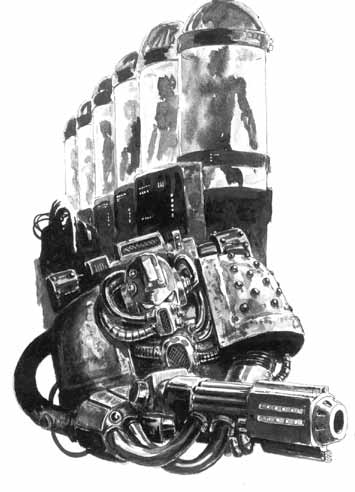 Reproducing Zygotes Reproducing ZygotesGene-seed can only be obtained by removing one or both progenoid organs from a living (or very recently deceased) Marine. For this purpose, Space Marine Apothecaries carry a special device known as a redactor, which they can use in battlefield conditions to remove the progenoid glands of a fallen Marine. The whole purpose of the progenoid organ is to provide gene-seed to enable the Chapter to continue. It is not possible to create a zygote in any other way. Each Chapter's stock of gene-seed is therefore unique to itself. Gene-seed has a great deal of religious significance to a Chapter, representing its identity and future. Without gene-seed, a Chapter has no future. The extinction of a type of gene-seed means that a zygote has been lost forever. The extinction of a Phase 18 or 19 gene-seed would effectively mean an end to a Chapter. As each Marine has only two progenoid glands, the rate at which a Chapter can create new Marines is restricted. It may take many years for a Chapter to rebuild itself after heavy losses. Gene-seed is often rendered useless if a Marine is exposed to high radiation levels or other forms of genetic disturbance. The efficiency of different Chapters' progenoid gene-seed also varies, so some Chapters are able to make up their numbers faster than others. According to their charter, each Chapter is obliged to send 5% of its genetic material to the Adeptus Mechanicus on Mars. This 'tithe' has two purposes. Firstly, it enables the Adeptus Mechanicus to monitor the health of each Marine Chapter. Secondly, it enables the Adeptus Mechanicus to store gene-seed with a view to founding new Chapters.
The various implants cause vital changes in a Marine's physique and mental state. Many of these changes are controlled by natural hormonal secretions and growth patterns. Implants may not prove effective, or may not become fully functional, if they are carried out once the recipient has reached certain stages of natural development. It is therefore inevitable that recruits must be reasonably young. Tissue compatibility is also essential, otherwise organs may fail to develop properly. The third consideration is mental suitability. The catalepsean node, occulobe, and sus-an membrane will only develop to a useable condition under the stimulus of hypnotic-suggestion. A recruit must therefore be susceptible to this particular treatment. These considerations mean that only a small proportion of people can become Space Marines. They must be male because zygotes are keyed to male hormones and tissue types, hence the need for tissue compatibility tests and psychological screening. If these tests prove successful, a candidate becomes a neophyte. With the completion of organ implantation and attendant chemical and hypnotic training, the subject becomes an initiate. An initiate receives training before joining the ranks as a full brother. A Marine usually joins the ranks between the ages of 16-18, but such are the hormonal changes induced by the process of creating a Space Marine that recruits are physically fully grown before then. Pressures during wartime may accelerate the process. Although the Chapters are careful to select only the most suitable candidates, not all neophytes survive to become initiates. This is due in part to the degeneration of knowledge amongst the individual Chapters that makes screening procedures less effective than they once were. Nor are operational methods entirely satisfactory in some cases. In many Chapters implant surgery is heavily ritualised, and is often accompanied by scarring, incantation, periods of prayer, fasting and all sorts of mystical practices which compromise medical efficiency. For example, the Space Wolves' Phase 17 implant has slightly mutated so that Space Wolves' canine teeth continue to grow throughout their lives, turning them into vicious fangs over several centuries. The length of fangs is a source of Chapter it tradition, and is even part of their organisation, hence the veterans of their heavy weapons squads being known as Long Fangs. Another Chapter about whom there is widespread rumour regarding their gene-seed are the Blood Angels. They often lapse into a battle-induced frenzy, known as the Black Rage, and can become berserk warriors who thirst for blood and raw flesh. The Blood Angels search eternally for a cure to the Curse of Sanguinius, but at the same time the Death Companies made up of such Marines are highly valuable shock troops, who are almost impervious to pain and rend apart their foes with their bare hands. 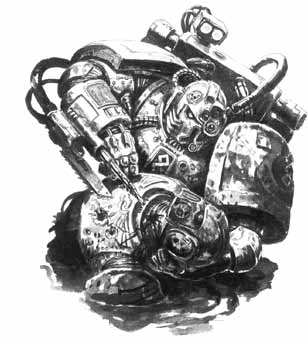
Another extreme example of gene-seed deterioration can be found in the Black Dragons Chapter, whose Ossmodula implant functions in an abnormal way. This leads to the growth of bony crests on the head, and blade-like protuberances from the forearm and elbow. Like the Death Company of the Blood Angels, warriors inflicted with such abnormal developments are formed into a separate fighting unit. Known as the Dragon Claws, they sharpen their additional protrusions and sheath them in adamantium to turn them into vicious close combat weapons. If an implant fails to develop properly, it is likely that a Marine's metabolism will become badly out of synchronisation. He may fall into a catatonic state or suffer bouts of hyperactivity. In either event, he will probably die. Those unfortunates that do not die almost invariably suffer mental damage, degenerating into homicidal maniacs or gibbering idiots. When a Chapter is at full strength these misfits may be put out of their misery. However, if the Chapter is short of Marines they are often allowed to live, and may be placed within their own special units. Those who display uncontrollably psychotic tendencies can be recruited into suicide assault squads. 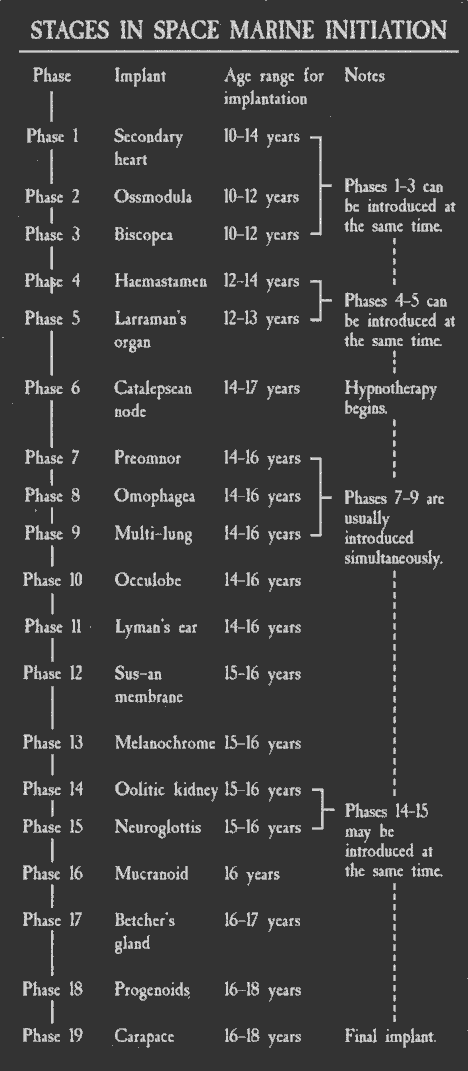
Some Chapters deliberately foster such creatures, even going so far as to implant deformed zygotes into some initiates. This is very dangerous, and the practice is discouraged by Imperial edict. But old traditions die hard.
Training - Physical training stimulates the implants and allows them to be tested for effectiveness. Indoctrination - A Marine is more than a human with extraordinary powers. Marines have extraordinary minds as well! Just as their bodies receive 19 separate implants, so their minds are altered to release the latent powers within. These mental powers are, if anything, more extraordinary than even the physical powers described previously. For example, a Marine can control his senses and nervous system to a remarkable degree, and can consequently endure pain that would kill an ordinary man. A Marine can also think and react at lightning speeds. Memory training is an important part of the indoctrination too. Some Marines develop photographic memories. Obviously, Marines vary in intelligence as do other men, and their individual mental abilities vary in degree. And thus is born another of the Imperium's finest warriors, an adamantium link in the armour of the Imperium. Implantation goes hand-in-hand with chemical treatment, psychological conditioning and subconscious hypnotherapy. All of these are essential if the Marine is to develop properly. Chemical treatment - Until his initiation, a Marine must submit to constant tests and examinations. The newly implanted organs must be monitored very carefully, imbalances corrected, and any sign of corrupt development treated. This chemical treatment is reduced after completion of the initiation process, but it never ends. Marines undergo periodic treatment for the rest of their lives in order to maintain a stable metabolism. This is why their power armour suits contain monitoring equipment and drug dispensers. Hypnotherapy - As the super-enhanced body grows, the recipient must learn how to use his new skills. Some of the implants, specifically the Phase 6 and 10 implants, can only function once correct hypnotherapy has been administered. Hypnotherapy is not always as effective as chemical treatment, but it can have substantial results. If a Marine can be taught how to control his own metabolism, his dependence on drugs is lessened. The process is undertaken in a machine called a hypnomat. Marines are placed in a state of hypnosis and subjected to visual and aural images in order to awaken their minds to their unconscious metabolic processes. |
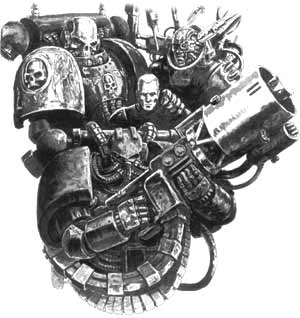 During
the Great Crusade, the Emperor encountered the Primarchs in turn, each
having risen to a position of authority within the cultures they had
been deposited in, due to their superhuman skills and physiques. It
was found that the genetic data of the Primarchs could be used to greatly
speed up the development of the organs and genetic material needed to
make a Space Marine, and the event known as the First Founding occurred.
Twenty Space Marine Legions were formed, each led by one of the Primarchs,
and his genetic data was passed on to his warriors. After the Primarch
Horus rebelled against the Emperor, the Legions were split into many
smaller fighting forces during the period known as the Second Founding.
These forces are called Chapters and consist of roughly a thousand battle
brothers.
During
the Great Crusade, the Emperor encountered the Primarchs in turn, each
having risen to a position of authority within the cultures they had
been deposited in, due to their superhuman skills and physiques. It
was found that the genetic data of the Primarchs could be used to greatly
speed up the development of the organs and genetic material needed to
make a Space Marine, and the event known as the First Founding occurred.
Twenty Space Marine Legions were formed, each led by one of the Primarchs,
and his genetic data was passed on to his warriors. After the Primarch
Horus rebelled against the Emperor, the Legions were split into many
smaller fighting forces during the period known as the Second Founding.
These forces are called Chapters and consist of roughly a thousand battle
brothers. 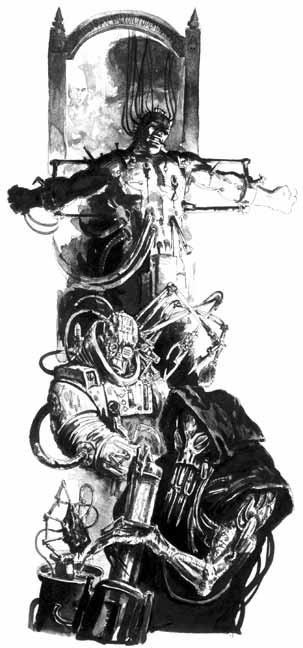 The
nineteen organs created by the ancient technicians of the Emperor are
described below. Each of these organs is extremely complicated and because
many of the organs only work properly when another organ is present,
the removal or mutation of one organ may affect the exact functioning
of the others. For these reasons, implants must be constantly monitored,
and many Marines have to undergo corrective surgery or chemotherapy
to re-balance their metabolism.
The
nineteen organs created by the ancient technicians of the Emperor are
described below. Each of these organs is extremely complicated and because
many of the organs only work properly when another organ is present,
the removal or mutation of one organ may affect the exact functioning
of the others. For these reasons, implants must be constantly monitored,
and many Marines have to undergo corrective surgery or chemotherapy
to re-balance their metabolism. 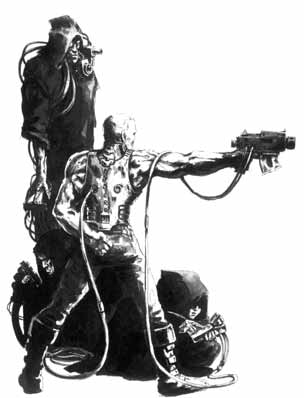 Phase
6 - Catalepsean Node. This brain implant is usually inserted into
the back of the skull via a hole drilled into the occipital bone. The
pea-sized organ influences the circadian rhythms of sleep and the body's
response to sleep deprivation. Normally, a Marine sleeps like any normal
man, but if deprived of sleep, the catalepsean node 'cuts in'. A man
implanted with the node is capable of sleeping and remaining awake at
the same time by 'switching off' areas of the brain sequentially. This
process cannot replace normal sleep entirely, but increases a Marine's
survivability by allowing awareness of the environment whilst resting.
Phase
6 - Catalepsean Node. This brain implant is usually inserted into
the back of the skull via a hole drilled into the occipital bone. The
pea-sized organ influences the circadian rhythms of sleep and the body's
response to sleep deprivation. Normally, a Marine sleeps like any normal
man, but if deprived of sleep, the catalepsean node 'cuts in'. A man
implanted with the node is capable of sleeping and remaining awake at
the same time by 'switching off' areas of the brain sequentially. This
process cannot replace normal sleep entirely, but increases a Marine's
survivability by allowing awareness of the environment whilst resting.
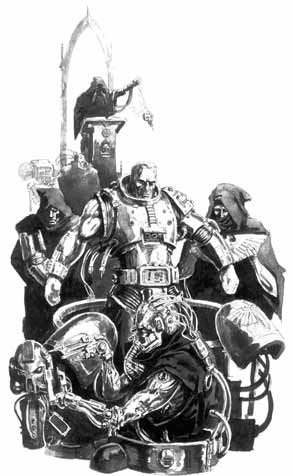 Phase
18 - Progenoids. There are two of these glands, one situated in
the neck, the other deep within the chest cavity. These glands are important
to the survival of the Marine's Chapter. Each organ grows within the
Marine, absorbing hormonal stimuli and genetic material from the other
implants. After five years, the neck gland is mature and ready for removal.
After ten years, the chest gland becomes mature and is also ready for
removal. A gland may be removed any time after it has matured. These
glands represent a Chapter's only source of gene-seed. When mature,
each gland contains a single gene-seed corresponding to each zygote
implanted into the recipient Marine. Once removed by surgery, the progenoid
must be carefully prepared, its individual gene-seeds checked for mutation,
and sound gene-seeds stored. Gene-seeds can be stored indefinitely under
suitable conditions.
Phase
18 - Progenoids. There are two of these glands, one situated in
the neck, the other deep within the chest cavity. These glands are important
to the survival of the Marine's Chapter. Each organ grows within the
Marine, absorbing hormonal stimuli and genetic material from the other
implants. After five years, the neck gland is mature and ready for removal.
After ten years, the chest gland becomes mature and is also ready for
removal. A gland may be removed any time after it has matured. These
glands represent a Chapter's only source of gene-seed. When mature,
each gland contains a single gene-seed corresponding to each zygote
implanted into the recipient Marine. Once removed by surgery, the progenoid
must be carefully prepared, its individual gene-seeds checked for mutation,
and sound gene-seeds stored. Gene-seeds can be stored indefinitely under
suitable conditions. 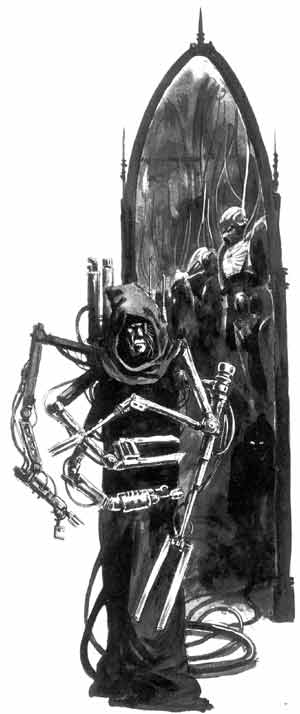 A
new Chapter cannot be founded overnight. A single suitable gene-seed
must be selected for each zygote. Zygotes are then grown in culture
and implanted into human test-slaves. These test-slaves must be biologically
compatible and free from mutation. Test-slaves spend their entire lives
bound in static experimental capsules. Although conscious, they are
completely immobile, serving as little more than mediums within which
the various zygotes can develop. From the original slave come two progenoids,
which are implanted within two more slaves, from which come four progenoids
and so on. It takes about 55 years of constant reproduction to produce
1,000 healthy sets of organs. These must be officially sanctioned by
the Master of Adeptus Mechanicus and then by the High Lords of Terra
speaking for the Emperor. Only the Emperor can give permission for the
creation of a new Chapter.
A
new Chapter cannot be founded overnight. A single suitable gene-seed
must be selected for each zygote. Zygotes are then grown in culture
and implanted into human test-slaves. These test-slaves must be biologically
compatible and free from mutation. Test-slaves spend their entire lives
bound in static experimental capsules. Although conscious, they are
completely immobile, serving as little more than mediums within which
the various zygotes can develop. From the original slave come two progenoids,
which are implanted within two more slaves, from which come four progenoids
and so on. It takes about 55 years of constant reproduction to produce
1,000 healthy sets of organs. These must be officially sanctioned by
the Master of Adeptus Mechanicus and then by the High Lords of Terra
speaking for the Emperor. Only the Emperor can give permission for the
creation of a new Chapter.